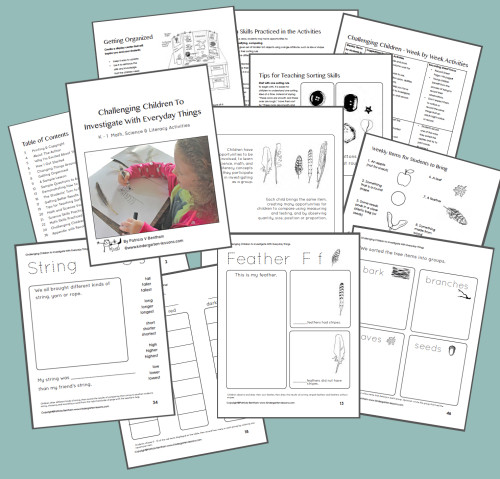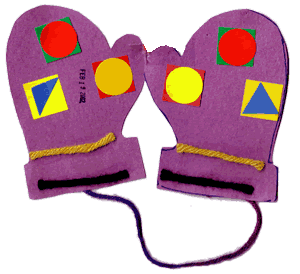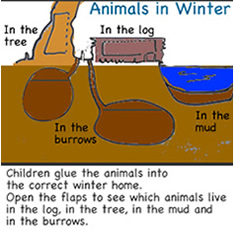Snow days are a novelty here on the west coast of Canada. Most of our winter precipitation is liquid, so when it freezes or snows we are all very excited! A winter theme or topic offers many opportunities for children to investigate math and science concepts.
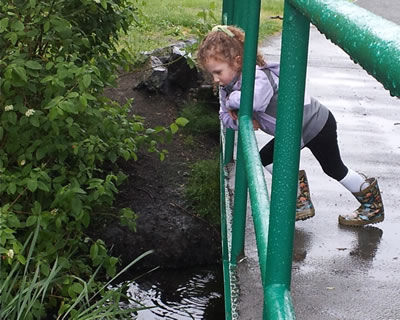
Changes in winter weather provide so many possibilities for children to observe and investigate snow, ice, slush, rain and temperature changes.
Science vocabulary can be introduced to describe states of water, frosty winter panes, and other winter objects and occurrences.
Read below for ideas to present symmetry, ordinal numbers, and classification, to review pattern, to make a snowman graph and more.
 Teacher tip! Don’t get hooked into using prepackaged winter themes, full of worksheets and identical busy work crafts. Trust in your students’ natural curiosity to explore winter science and math activities. Give them an interesting environment and watch them carry out in-depth explorations.
Teacher tip! Don’t get hooked into using prepackaged winter themes, full of worksheets and identical busy work crafts. Trust in your students’ natural curiosity to explore winter science and math activities. Give them an interesting environment and watch them carry out in-depth explorations.
Symmetry
After playing with the idea of symmetry with real objects, cut out mittens (tracer here) and place the same stickers on each mitten.
- Children trace mittens on a folded piece of construction paper
- Cut out and put on table with the thumbs touching
- Each time the children put a sticker on one mitten they are challenged to put the same sticker on the other mitten in the same place.
Review ordinal numbers
The book, “The Mitten“ by Jan Brett, is perfect for creating opportunities to use ordinal numbers. More about ordinal numbers in this post. As part of your Winter Theme, read and reread the book, then discuss which animal went into the mitten first? Which animal went in second? third?
See the next page for more ideas about “The Mitten”.
Review calendar math
Review the names of the seasons, the months of the year, calendar vocabulary
Classify winter things
Every day bring a new group of winter objects, clothing or food into the classroom. Talk about how they are the same or different. If you like, finish with a snowman winter word book here.
Scarf pattern activity

Materials
- Cut a 12 x 18 sheet of colored construction paper in half, cut a bit wavy to make them look like scarfs, each side of the paper makes a scarf
- Stickers in geometrical shapes
- Glue
- Scissors
Procedure:
- Children fringe the edges with scissors
- Children glue stickers on the paper scarf to make two rows of pattern.
Read a thermometer
- Collect and record data and make comparisons
- See Math Measurement page for details on how to have the children compare each day using red strips of paper.
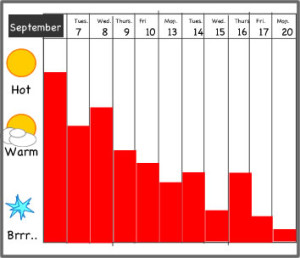
Make a snowman “name” graph
- Students take one circle for each letter of their name and one more for a head
- Arrange finished snow guys on the bulletin board
- Count everyone’s snowman balls
- Talk about – are there fewer (or more) names with 7 letters, 5 letters etc.
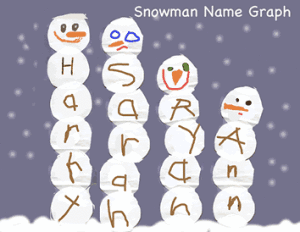
Science activities
Once again, rather than handing out worksheets from a winter theme, set up interesting experiments for the kids to observe and then record their observations. Recorded observations can be on a group chart or a whiteboard. Separate pieces of paper are not necessary.
Discover the Power of Ice
- Fill an empty jam jar to the top with colored water, place in a plastic bag on a tray in the freezer
- Discuss what happened. Why did the glass break?
- Have the children do an observation drawing of the jar before and after it goes into the freezer
Bring snow inside to increase Winter vocabulary
- Fill the water center with a bucket of snow and sprinkle drops of food coloring mixed with water on it
- Let the children observe and play with the snow
- Use the terms such as “absorb, absorption, thaw, melt, liquefy, defrost, soften, dissolve” to describe the food coloring absorbing and the snow melting
- Give the children large classroom thermometers to observe the red liquid go up and down as they stick them in the snow
Observe and record data
- Make identical size snowballs and place them in bowls in various areas of the room, close to the heater, near a window, on the counter, etcetera.
- Observe and record on a class chart which snowball melts first, second, or third
- Stamp or draw pictures of the clock face when you start and when you finish.
- A large clock stamp is useful for many science activities. Although most of the children can not tell the time, they build concepts of periods of time passing and how the hands on the clock move about.
A winter investigation is an ideal time for children to discover the states of water
- Find a parent helper to guard children if you are using a heated object
- Bring a kettle (a glass cooking pot and a burner is even better for observations) into the room and let the children observe as you put a small amount of cool water in it and then watch the steam come out. Discuss why?
- Hold a cold piece of metal or Plexiglas above the steam and observe as condensation forms. Ask the children why they think the water is forming on the metal.
- Pour a small amount of very hot water into a large jar, put a lid on it, hold it and let the children observe the steam filling the jar.
- Introduce the terms steam, vapor, gas, mist, fog, liquid, solid, evaporate, condensation and moisture

TEACHER TIP – Always use a parent helper or assistant when activities call for hot irons, hot water, or cooking.
The parent helper has one responsibility only – to guard the kettle or iron or hot water and make sure that the children do not get too close and to remove it from the room immediately after the investigation. That way you are free to engage with the children, have your attention diverted, without the worry of burns or scalds.
Introduce the concept of hibernation
- Read Time to Sleep (An Owlet Book) by Denise Fleming
- Talk about animals that sleep through the winter
- Introduce the word hibernate
- Make step-by-step drawings of a winter scene including a log, a pond, a tree and a rock
- The children glue animal pictures in the correct winter homes (free download)
- Make fold back flaps to glue on top.
Shoebox Hibernation Caves & Dens…
- Supply shoeboxes for the kids to create caves or dens and other hibernation habitats.
- Provide rubber animals that hibernate
Looking for a quick and easy way to make science and math activities available that include observations about quantity, size, position and/or proportion?
Check out my ebook,“Challenging Children to Investigate With Everyday Things”, on the store page. It will not only show you how to encourage children to record their observations and new knowledge in different ways, it provides over 50 open-ended recording sheets to help you get started.
